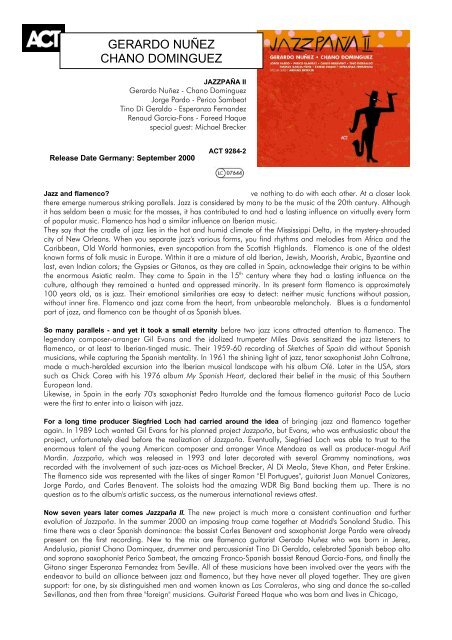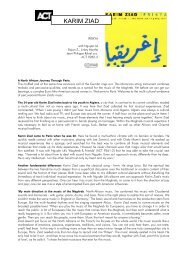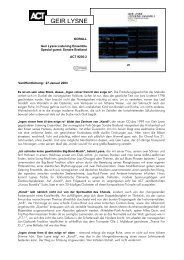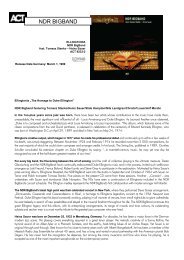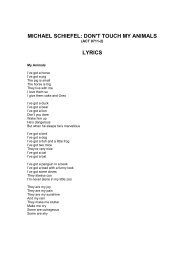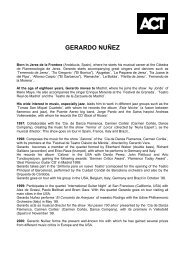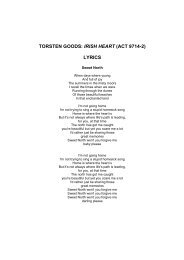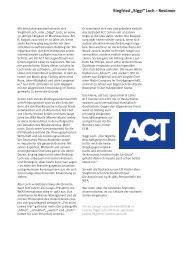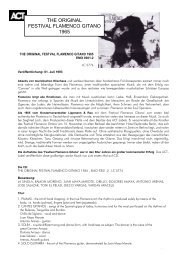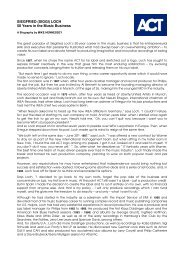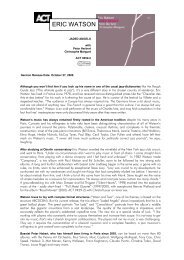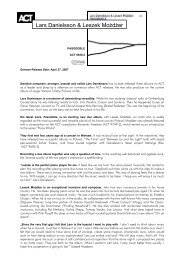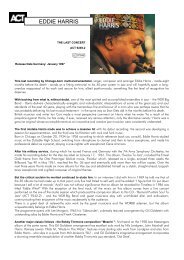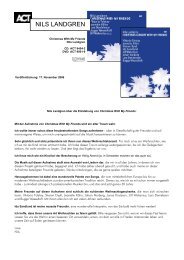GERARDO NUÑEZ CHANO DOMINGUEZ
GERARDO NUÑEZ CHANO DOMINGUEZ
GERARDO NUÑEZ CHANO DOMINGUEZ
Create successful ePaper yourself
Turn your PDF publications into a flip-book with our unique Google optimized e-Paper software.
<strong>GERARDO</strong> <strong>NUÑEZ</strong><br />
<strong>CHANO</strong> <strong>DOMINGUEZ</strong><br />
JAZZPAÑA II<br />
Gerardo Nuñez - Chano Dominguez<br />
Jorge Pardo - Perico Sambeat<br />
Tino Di Geraldo - Esperanza Fernandez<br />
Renaud Garcia-Fons - Fareed Haque<br />
special guest: Michael Brecker<br />
Release Date Germany: September 2000<br />
ACT 9284-2<br />
Jazz and flamenco? At first glance these are two worlds that have nothing to do with each other. At a closer look<br />
there emerge numerous striking parallels. Jazz is considered by many to be the music of the 20th century. Although<br />
it has seldom been a music for the masses, it has contributed to and had a lasting influence on virtually every form<br />
of popular music. Flamenco has had a similar influence on Iberian music.<br />
They say that the cradle of jazz lies in the hot and humid climate of the Mississippi Delta, in the mystery-shrouded<br />
city of New Orleans. When you separate jazz's various forms, you find rhythms and melodies from Africa and the<br />
Caribbean, Old World harmonies, even syncopation from the Scottish Highlands. Flamenco is one of the oldest<br />
known forms of folk music in Europe. Within it are a mixture of old Iberian, Jewish, Moorish, Arabic, Byzantine and<br />
last, even Indian colors; the Gypsies or Gitanos, as they are called in Spain, acknowledge their origins to be within<br />
the enormous Asiatic realm. They came to Spain in the 15 th century where they had a lasting influence on the<br />
culture, although they remained a hunted and oppressed minority. In its present form flamenco is approximately<br />
100 years old, as is jazz. Their emotional similarities are easy to detect: neither music functions without passion,<br />
without inner fire. Flamenco and jazz come from the heart, from unbearable melancholy. Blues is a fundamental<br />
part of jazz, and flamenco can be thought of as Spanish blues.<br />
So many parallels - and yet it took a small eternity before two jazz icons attracted attention to flamenco. The<br />
legendary composer-arranger Gil Evans and the idolized trumpeter Miles Davis sensitized the jazz listeners to<br />
flamenco, or at least to Iberian-tinged music. Their 1959-60 recording of Sketches of Spain did without Spanish<br />
musicians, while capturing the Spanish mentality. In 1961 the shining light of jazz, tenor saxophonist John Coltrane,<br />
made a much-heralded excursion into the Iberian musical landscape with his album Olé. Later in the USA, stars<br />
such as Chick Corea with his 1976 album My Spanish Heart, declared their belief in the music of this Southern<br />
European land.<br />
Likewise, in Spain in the early 70's saxophonist Pedro Iturralde and the famous flamenco guitarist Paco de Lucia<br />
were the first to enter into a liaison with jazz.<br />
For a long time producer Siegfried Loch had carried around the idea of bringing jazz and flamenco together<br />
again. In 1989 Loch wanted Gil Evans for his planned project Jazzpaña, but Evans, who was enthusiastic about the<br />
project, unfortunately died before the realization of Jazzpaña. Eventually, Siegfried Loch was able to trust to the<br />
enormous talent of the young American composer and arranger Vince Mendoza as well as producer-mogul Arif<br />
Mardin. Jazzpaña, which was released in 1993 and later decorated with several Grammy nominations, was<br />
recorded with the involvement of such jazz-aces as Michael Brecker, Al Di Meola, Steve Khan, and Peter Erskine.<br />
The flamenco side was represented with the likes of singer Ramon "El Portugues", guitarist Juan Manuel Canizares,<br />
Jorge Pardo, and Carles Benavent. The soloists had the amazing WDR Big Band backing them up. There is no<br />
question as to the album's artistic success, as the numerous international reviews attest.<br />
Now seven years later comes Jazzpaña II. The new project is much more a consistent continuation and further<br />
evolution of Jazzpaña. In the summer 2000 an imposing troup came together at Madrid's Sonoland Studio. This<br />
time there was a clear Spanish dominance: the bassist Carles Benavent and saxophonist Jorge Pardo were already<br />
present on the first recording. New to the mix are flamenco guitarist Gerado Nuñez who was born in Jerez,<br />
Andalusia, pianist Chano Dominquez, drummer and percussionist Tino Di Geraldo, celebrated Spanish bebop alto<br />
and soprano saxophonist Perico Sambeat, the amazing Franco-Spanish bassist Renaud Garcia-Fons, and finally the<br />
Gitano singer Esperanza Fernandez from Seville. All of these musicians have been involved over the years with the<br />
endeavor to build an alliance between jazz and flamenco, but they have never all played together. They are given<br />
support: for one, by six distinguished men and women known as Las Corraleras, who sing and dance the so-called<br />
Sevillanas, and then from three "foreign" musicians. Guitarist Fareed Haque who was born and lives in Chicago,
<strong>GERARDO</strong> <strong>NUÑEZ</strong> - <strong>CHANO</strong> <strong>DOMINGUEZ</strong><br />
creates an interesting contrast to the playing of Gerardo Nuñez. The American Michael Brecker is not only the most<br />
documented but also the most imitated saxophonist of his generation. His prolific studio work has not dampened the<br />
fire in his playing, as one can clearly hear on Jazzpaña II. Englander Colin Towns takes care for some atmospheric<br />
arrangements.<br />
Jazzpaña II is an album that wishes to finally place the importance of the current Spanish jazz scene in the right light.<br />
Authenticity is so important that it prevails in the musical foreground like a vision. The music signals the versatility and<br />
multi-faceted richness of flamenco and jazz.<br />
Both music styles are worthless without the receptivity of their protagonists. The openness extended by all involved with<br />
Jazzpaña II has resulted in a music that sounds as if flamenco and jazz have somehow always belonged together.<br />
The CD: Gerardo Nuñez - Chano Dominguez - Jazzpaña II - ACT 9284-2 - LC 07644<br />
Line Up:<br />
Gerardo Nuñez (acoustic guitar), Chano Dominguez (piano), Fareed Haque (acoustic + electric guitar)<br />
Jorge Pardo (tenor + soprano sax, flute), Perico Sambeat (alto + soprano sax), Carles Benavent (electric bass)<br />
Renaud Garcia-Fons (acoustic bass), Tino Di Geraldo (percussion + drums) Cepillo (cajón), Esperanza Fernandez<br />
(vocal), Las Corraleras (vocal + percussion), Colin Towns, arrangements (*)<br />
Special Guest: Michael Brecker, tenor sax<br />
Tracks:<br />
1 Calima (G. Nuñez) * 2 Un Amor Real (G. Nuñez) 3a La Liebre (P. Peña) 3b Plaza Jazzpaña (G. Nuñez)<br />
4 Alma de Mujer (C. Dominguez) 5 Blues for Pablo (Gil Evans) 6 Latido Loco (R. Garcia-Fons)<br />
7 Jerez-Chicago (G. Nuñez) 8 Paso for El (J. Pardo) 9 Mister Señor (C. Dominguez) 10 Que tambien es de Sevilla<br />
(P. Obregón) 11 Samaruco (Buleria)(G. Nuñez) 12 Para Chick (C. Dominguez) 13 Bluesoléa (G. Nuñez)<br />
Produced by Siegfried Loch<br />
24bit Digital Recording in Madrid, June 2000<br />
Co-produced by S.G.A.E.<br />
Ehrengutstrasse 28, 80469 München, Germany<br />
Phone +49 89 72 94 92 0, Fax +49 89 72 94 92 11<br />
e-mail: info@actmusic.com<br />
Visit our website at http://www.actmusic.com


